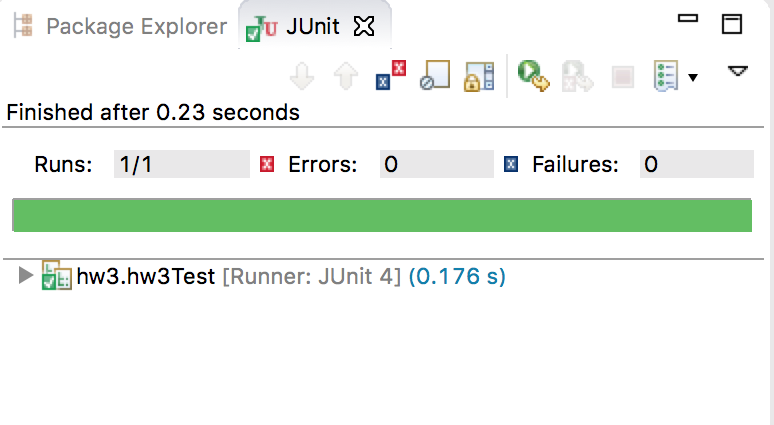软件测试 homework3
软件工程3班 3015201231 王立凯
Use the following method printPrimes() for questions a–d.
(a) Draw the control flow graph for the printPrime() method.

(b) Consider test cases t1 = (n = 3) and t2 = ( n = 5). Although these tour the same prime paths in printPrime(), they don't necessarily find the same faults. Design a simple fault that t2 would be more likely to discover than t1 would.
n越大,数组更可能越界,如当MAXPRIMES = 3 时, t2=(n=5) 会溢出 ,t1=(n=3) 不会溢出
(c) For printPrime(), find a test case such that the corresponding test path visits the edge that connects the beginning of the while statement
to the for statement without going through the body of the while loop.
n=1
此时不满足numPrimes<n,直接跳过while循环
(d) Enumerate the test requirements for node coverage, edge coverage,and prime path coverage for the path for printPrimes().
node coverage:
TR={1,2,3,4,5,6,7,8,9,10,11,12,13,14,15,16}
edge coverage:
TR={ (1,2) , (2,3) , (3,4) , (4,5) , (5,6) , (6,7) , (6,8) , (7,5) , (8,9) , (5,9) , (9,10) , (9,11) , (10,2) , (11,2) , (2,12) , (12,13) , (13,14) , (14,15) , (15,13) , (13,16) }
prime path coverage:
TR={ [1,2,3,4,5,6,7] , [1,2,3,4,5,9,10] , [1,2,3,4,5,9,11] , [1,2,3,4,5,6,8,9,10] , [1,2,3,4,5,6,8,9,11] , [1,2,12,13,14,15] , [1,2,12,13,16] , [2,3,4,5,6,8,9,10,2] , [2,3,4,5,6,8,9,11,2] , [2,3,4,5,9,10,2] , [2,3,4,5,9,11,2] ,
[3,4,5,6,8,9,10,2,3] , [3,4,5,6,8,9,11,2,3] , [3,4,5,9,10,2,3] , [3,4,5,9,11,2,3] ,
[4,5,6,8,9,10,2,3,4] , [4,5,6,8,9,11,2,3,4] , [4,5,9,10,2,3,4] , [4,5,9,11,2,3,4] ,
[5,6,7,5] , [5,6,8,9,10,2,3,4,5] , [5,6,8,9,11,2,3,4,5] , [5,9,10,2,3,4,5] , [5,9,11,2,3,4,5] ,
[6,7,5,6] , [6,8,9,10,2,3,4,5,6] , [6,8,9,11,2,3,4,5,6] ,
[7,5,6,7] ,
[8,9,10,2,3,4,5,6,8] , [8,9,11,2,3,4,5,6,8] ,
[9,10,2,3,4,5,6,8,9] , [9,11,2,3,4,5,6,8,9] , [9,10,2,3,4,5,9] , [9,11,2,3,4,5,9] ,
[10,2,3,4,5,6,8,9,10] , [10,2,3,4,5,9,10] ,
[11,2,3,4,5,6,8,9,11] , [11,2,3,4,5,9,11] ,
[13,14,15,13] ,
[14,15,13,14] ,
[15,13,14,15] }
– 基于Junit及Eclemma(jacoco)实现一个主路径覆盖的测试
hw3.java
package hw3;
public class hw3 {
private static final int MAXPRIMES = 100000000;
public static void printPrimes(int n) {
int curPrime;
int numPrimes;
boolean isPrime;
int[] primes = new int[MAXPRIMES];
primes[0] = 2;
numPrimes = 1;
curPrime = 2;
while (numPrimes < n) {
curPrime++;
isPrime = true;
for (int i = 0; i <= numPrimes - 1; i++) {
if (curPrime % primes[i] == 0) {
isPrime = false;
break;
}
}
if (isPrime) {
primes[numPrimes] = curPrime;
numPrimes++;
}
}
for (int i = 0; i <= numPrimes - 1; i++) {
System.out.println("Prime: " + primes[i] );
}
}
}
hw3Test.java
package hw3;
import static org.junit.Assert.*;
import java.io.ByteArrayOutputStream;
import java.io.IOException;
import java.io.PrintStream;
import org.junit.Before;
import org.junit.Test;
public class hw3Test {
ByteArrayOutputStream out;
PrintStream ps;
public hw3 primes = new hw3();
int [] print = {2, 3, 5};
@Before
public void setUp(){
out = new ByteArrayOutputStream();
ps = new PrintStream(out);
System.setOut(ps);
}
@Test
public void test() throws IOException {
out.flush();
hw3.printPrimes(6);
assertEquals("Prime: 2\nPrime: 3\nPrime: 5\nPrime: 7\nPrime: 11\nPrime: 13\n", out.toString());
}
}
运行结果:



